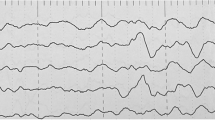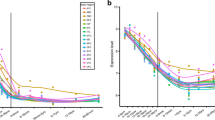Abstract
Focal epilepsy accounts for 60% of all forms of epilepsy, but the pathogenic mechanism is not well understood. In this study, three novel mutations in NPRL3 (nitrogen permease regulator-like 3), c.937_945del, c.1514dupC and 6,706-bp genomic DNA (gDNA) deletion, were identified in three families with focal epilepsy by linkage analysis, whole exome sequencing (WES) and Sanger sequencing. NPRL3 protein is a component of the GATOR1 complex, a major inhibitor of mTOR signaling. These mutations led to truncation of the NPRL3 protein and hampered the binding between NPRL3 and DEPDC5, which is another component of the GATOR1 complex. Consequently, the mutant proteins enhanced mTOR signaling in cultured cells, possibly due to impaired inhibition of mTORC1 by GATOR1. Knockdown of nprl3 in Drosophila resulted in epilepsy-like behavior and abnormal synaptic development. Taken together, these findings expand the genotypic spectrum of NPRL3-associated focal epilepsy and provide further insight into how NPRL3 mutations lead to epilepsy.
Similar content being viewed by others
References
Baldassari, S., Picard, F., Verbeek, N.E., van Kempen, M., Brilstra, E.H., Lesca, G., Conti, V., Guerrini, R., Bisulli, F., Licchetta, L., et al. (2019). The landscape of epilepsy-related GATOR1 variants. Genet Med 21, 398–408.
Bar-Peled, L., Chantranupong, L., Cherniack, A.D., Chen, W.W., Ottina, K. A., Grabiner, B.C., Spear, E.D., Carter, S.L., Meyerson, M., and Sabatini, D.M. (2013). A tumor suppressor complex with GAP activity for the Rag GTPases that signal amino acid sufficiency to mTORC1. Science 340, 1100–1106.
Bedrosian, T.A., Miller, K.E., Grischow, O.E., Schieffer, K.M., LaHaye, S., Yoon, H., Miller, A.R., Navarro, J., Westfall, J., Leraas, K., et al. (2022). Detection of brain somatic variation in epilepsy-associated developmental lesions. Epilepsia 63, 1981–1997.
Brent, J.R., Werner, K.M., and McCabe, B.D. (2009). Drosophila larval NMJ dissection. J Vis Exp 24, e1107.
Bu, B., He, W., Song, L., and Zhang, L. (2019). Nuclear envelope protein MAN1 regulates the Drosophila circadian clock via period. Neurosci Bull 35, 969–978.
Canavati, C., Klein, K.M., Afawi, Z., Pendziwiat, M., Abu Rayyan, A., Kamal, L., Zahdeh, F., Qaysia, I., Helbig, I., and Kanaan, M. (2019). Inclusion of hemimegalencephaly into the phenotypic spectrum of NPRL3 pathogenic variants in familial focal epilepsy with variable foci. Epilepsia 60, e67–e73.
Chen, J., Ou, Y., Luo, R., Wang, J., Wang, D., Guan, J., Li, Y., Xia, P., Chen, P.R., and Liu, Y. (2021). SAR1B senses leucine levels to regulate mTORC1 signalling. Nature 596, 281–284.
Chung, C., Yang, X., Bae, T., Vong, K.I., Mittal, S., Donkels, C., Westley Phillips, H., Li, Z., Marsh, A.P.L., Breuss, M.W., et al. (2023). Comprehensive multi-omic profiling of somatic mutations in malformations of cortical development. Nat Genet 55, 209–220.
Crompton, D.E., Scheffer, I.E., Taylor, I., Cook, M.J., McKelvie, P.A., Vears, D.F., Lawrence, K.M., McMahon, J.M., Grinton, B.E., McIntosh, A.M., et al. (2010). Familial mesial temporal lobe epilepsy: a benign epilepsy syndrome showing complex inheritance. Brain 133, 3221–3231.
Dawson, R.E., Nieto Guil, A.F., Robertson, L.J., Piltz, S.G., Hughes, J.N., and Thomas, P.Q. (2020). Functional screening of GATOR1 complex variants reveals a role for mTORC1 deregulation in FCD and focal epilepsy. Neurobiol Dis 134, 104640.
Devinsky, O., Vezzani, A., O’Brien, T.J., Jette, N., Scheffer, I.E., de Curtis, M., and Perucca, P. (2018). Epilepsy. Nat Rev Dis Primers 4, 18024.
Dibbens, L.M., de Vries, B., Donatello, S., Heron, S.E., Hodgson, B.L., Chintawar, S., Crompton, D.E., Hughes, J.N., Bellows, S.T., Klein, K. M., et al. (2013). Mutations in DEPDC5 cause familial focal epilepsy with variable foci. Nat Genet 45, 546–551.
Dutchak, P.A., Laxman, S., Estill, S.J., Wang, C., Wang, Y., Wang, Y., Bulut, G.B., Gao, J., Huang, L.J., and Tu, B.P. (2015). Regulation of hematopoiesis and methionine homeostasis by mTORC1 Inhibitor NPRL2. Cell Rep 12, 371–379.
Fridell, Y.W.C., Sánchez-Blanco, A., Silvia, B.A., and Helfand, S.L. (2005). Targeted expression of the human uncoupling protein 2 (hUCP2) to adult neurons extends life span in the fly. Cell Metab 1, 145–152.
Grinnell, A.D. (1995). Dynamics of nerve-muscle interaction in developing and mature neuromuscular junctions. Physiol Rev 75, 789–834.
Hauser, R.M., Henshall, D.C., and Lubin, F.D. (2018). The epigenetics of epilepsy and its progression. Neuroscientist 24, 186–200.
Hughes, J., Dawson, R., Tea, M., McAninch, D., Piltz, S., Jackson, D., Stewart, L., Ricos, M.G., Dibbens, L.M., Harvey, N.L., et al. (2017). Knockout of the epilepsy gene Depdc5 in mice causes severe embryonic dysmorphology with hyperactivity of mTORC1 signalling. Sci Rep 7, 12618.
Ishida, S., Zhao, D., Sawada, Y., Hiraoka, Y., Mashimo, T., and Tanaka, K. (2022). Dorsal telencephalon-specific Nprl2- and Nprl3-knockout mice: novel mouse models for GATORopathy. Hum Mol Genet 31, 1519–1530.
Ji, Y., and Clark, D.V. (2006). The purine synthesis gene Prat2 is required for Drosophila metamorphosis, as revealed by inverted-repeat-mediated RNA interference. Genetics 172, 1621–1631.
Jones, N.C., O’Brien, T.J., and Carmant, L. (2014). Interaction between sex and early-life stress: Influence on epileptogenesis and epilepsy comorbidities. Neurobiol Dis 72, 233–241.
Keshishian, H., Broadie, K., Chiba, A., and Bate, M. (1996). The Drosophila neuromuscular junction: a model system for studying synaptic development and function. Annu Rev Neurosci 19, 545–575.
Kingdom, R., and Wright, C.F. (2022). Incomplete penetrance and variable expressivity: from clinical studies to population cohorts. Front Genet 13, 920390.
Korenke, G.C., Eggert, M., Thiele, H., Nürnberg, P., Sander, T., and Steinlein, O.K. (2016). Nocturnal frontal lobe epilepsy caused by a mutation in the GATOR1 complex gene NPRL3. Epilepsia 57, e60–e63.
Kowalczyk, M.S., Hughes, J.R., Babbs, C., Sanchez-Pulido, L., Szumska, D., Sharpe, J.A., Sloane-Stanley, J.A., Morriss-Kay, G.M., Smoot, L.B., Roberts, A.E., et al. (2012). Nprl3 is required for normal development of the cardiovascular system. Mamm Genome 23, 404–415.
Li, Y., Zhao, X., Wang, S., Xu, K., Zhao, X., Huang, S., and Zhu, S. (2021). A novel loss-of-function mutation in the NPRL3 gene identified in Chinese familial focal epilepsy with variable foci. Front Genet 12, 766354.
Liu, H., Du, C., Luo, J., Qiu, X., Li, Z., Lou, Q., Yin, Z., and Zheng, F. (2017). A novel mutation in nuclear prelamin a recognition factor-like causes diffuse pulmonary arteriovenous malformations. Oncotarget 8, 2708–2718.
Liu, J.Y., Dai, X., Sheng, J., Cui, X., Wang, X., Jiang, X., Tu, X., Tang, Z., Bai, Y., Liu, M., et al. (2008). Identification and functional characterization of a novel splicing mutation in RP gene PRPF31. Biochem Biophys Res Commun 367, 420–426.
Liu, L., Chen, Z.R., Xu, H.Q., Liu, D.T., Mao, Y., Liu, H.K., Liu, X.R., Zhou, P., Lin, S.M., Li, B., et al. (2020). DEPDC5 variants associated malformations of cortical development and focal epilepsy with febrile seizure plus/febrile seizures: the role of molecular sub-regional effect. Front Neurosci 14, 821.
Liu, Y., Tian, X., Ke, P., Gu, J., Ma, Y., Guo, Y., Xu, X., Chen, Y., Yang, M., Wang, X., et al. (2022). KIF17 modulates epileptic seizures and membrane expression of the NMDA receptor subunit NR2B. Neurosci Bull 38, 841–856.
McGuire, S.E., Mao, Z., and Davis, R.L. (2004). Spatiotemporal gene expression targeting with the TARGET and Gene-Switch systems in Drosophila. Sci STKE 2004(220), pl6.
McTague, A., Howell, K.B., Cross, J.H., Kurian, M.A., and Scheffer, I.E. (2016). The genetic landscape of the epileptic encephalopathies of infancy and childhood. Lancet Neurol 15, 304–316.
Menon, K.P., Carrillo, R.A., and Zinn, K. (2013). Development and plasticity of the Drosophila larval neuromuscular junction. WIREs Dev Biol 2, 647–670.
Myers, C.T., and Mefford, H.C. (2015). Advancing epilepsy genetics in the genomic era. Genome Med 7, 91.
Neklesa, T.K., and Davis, R.W. (2009). A genome-wide screen for regulators of TORC1 in response to amino acid starvation reveals a conserved Npr2/3 complex. PLoS Genet 5, e1000515.
Pavlidis, P., and Tanouye, M.A. (1995). Seizures and failures in the giant fiber pathway of Drosophila bang-sensitive paralytic mutants. J Neurosci 15, 5810–5819.
Perucca, P. (2018). Genetics of focal epilepsies: what do we know and where are we heading? Epilepsy Curr 18, 356–362.
Ribierre, T., Deleuze, C., Bacq, A., Baldassari, S., Marsan, E., Chipaux, M., Muraca, G., Roussel, D., Navarro, V., Leguern, E., et al. (2018). Second-hit mosaic mutation in mTORC1 repressor DEPDC5 causes focal cortical dysplasia-associated epilepsy. J Clin Invest 128, 2452–2458.
Ricos, M.G., Hodgson, B.L., Pippucci, T., Saidin, A., Ong, Y.S., Heron, S. E., Licchetta, L., Bisulli, F., Bayly, M.A., Hughes, J., et al. (2016). Mutations in the mammalian target of rapamycin pathway regulators NPRL2 and NPRL3 cause focal epilepsy. Ann Neurol 79, 120–131.
Riney, K., Bogacz, A., Somerville, E., Hirsch, E., Nabbout, R., Scheffer, I. E., Zuberi, S.M., Alsaadi, T., Jain, S., French, J., et al. (2022). International League Against Epilepsy classification and definition of epilepsy syndromes with onset at a variable age: position statement by the ILAE Task Force on Nosology and Definitions. Epilepsia 63, 1443–1474.
Saxton, R.A., and Sabatini, D.M. (2017). mTOR signaling in growth, metabolism, and disease. Cell 168, 960–976.
Scheffer, I.E., Bhatia, K.P., Lopes-Cendes, I., Fish, D.R., Marsden, C.D., Andermann, E., Andermann, F., Desbiens, R., Keene, D., Cendes, F., et al. (1995). Autosomal dominant nocturnal frontal lobe epilepsy. Brain 118, 61–73.
Scheffer, I.E., Phillips, H.A., O’Brien, C.E., Saling, M.M., Wrennall, J.A., Wallace, R.H., Mulley, J.C., and Berkovic, S.F. (1998). Familial partial epilepsy with variable foci: a new partial epilepsy syndrome with suggestion of linkage to chromosome 2. Ann Neurol 44, 890–899.
Schmid, A., Hallermann, S., Kittel, R.J., Khorramshahi, O., Frölich, A.M.J., Quentin, C., Rasse, T.M., Mertel, S., Heckmann, M., and Sigrist, S.J. (2008). Activity-dependent site-specific changes of glutamate receptor composition in vivo. Nat Neurosci 11, 659–666.
Shen, K., Huang, R.K., Brignole, E.J., Condon, K.J., Valenstein, M.L., Chantranupong, L., Bomaliyamu, A., Choe, A., Hong, C., Yu, Z., et al. (2018). Architecture of the human GATOR1 and GATOR1-Rag GTPases complexes. Nature 556, 64–69.
Sim, J.C., Scerri, T., Fanjul-Fernández, M., Riseley, J.R., Gillies, G., Pope, K., van Roozendaal, H., Heng, J.I., Mandelstam, S.A., McGillivray, G., et al. (2016). Familial cortical dysplasia caused by mutation in the mammalian target of rapamycin regulator NPRL3. Ann Neurol 79, 132–137.
Sone, D. (2021). Making the invisible visible: advanced neuroimaging techniques in focal epilepsy. Front Neurosci 15, 699176.
Staley, K. (2015). Molecular mechanisms of epilepsy. Nat Neurosci 18, 367–372.
Tang, B., Li, B., Gao, L.D., He, N., Liu, X.R., Long, Y.S., Zeng, Y., Yi, Y. H., Su, T., and Liao, W.P. (2020). Optimization of in silico tools for predicting genetic variants: individualizing for genes with molecular sub-regional stratification. Brief Bioinform 21, 1776–1786.
Wang, J., Lin, Z.J., Liu, L., Xu, H.Q., Shi, Y.W., Yi, Y.H., He, N., and Liao, W.P. (2017). Epilepsy-associated genes. Seizure 44, 11–20.
Watanabe-Asano, T., Kuma, A., and Mizushima, N. (2014). Cycloheximide inhibits starvation-induced autophagy through mTORC1 activation. Biochem Biophys Res Commun 445, 334–339.
Weckhuysen, S., Marsan, E., Lambrecq, V., Marchal, C., Morin-Brureau, M., An-Gourfinkel, I., Baulac, M., Fohlen, M., Kallay Zetchi, C., Seeck, M., et al. (2016). Involvement of GATOR complex genes in familial focal epilepsies and focal cortical dysplasia. Epilepsia 57, 994–1003.
Wei, Y., Reveal, B., Cai, W., and Lilly, M.A. (2016). The GATOR1 complex regulates metabolic homeostasis and the response to nutrient stress in Drosophila melanogaster. G3 6, 3859–3867.
Wolfson, R.L., Chantranupong, L., Saxton, R.A., Shen, K., Scaria, S.M., Cantor, J.R., and Sabatini, D.M. (2016). Sestrin2 is a leucine sensor for the mTORC1 pathway. Science 351, 43–48.
Wullschleger, S., Loewith, R., and Hall, M.N. (2006). TOR signaling in growth and metabolism. Cell 124, 471–484.
Acknowledgements
This work was supported by the National Natural Science Foundation of China (32270663, 31871262, U20A20355, 32022035), Shanghai Municipal Science and Technology Major Project (2018SHZDZX05), and the Ministry of Science and Technology of China STI 2030-Major Projects (2021ZD0203202). We would like to thank all the participants in this study. We would also like to thank the Tsinghua Fly Center for providing fly stocks.
Author information
Authors and Affiliations
Corresponding authors
Ethics declarations
Compliance and ethics The author(s) declare that they have no conflict of interest.
Electronic supplementary material
Supplementary material, approximately 3.15 MB.
Supplementary material, approximately 20.9 MB.
Rights and permissions
About this article
Cite this article
Du, S., Zeng, S., Song, L. et al. Functional characterization of novel NPRL3 mutations identified in three families with focal epilepsy. Sci. China Life Sci. 66, 2152–2166 (2023). https://doi.org/10.1007/s11427-022-2313-1
Received:
Accepted:
Published:
Issue Date:
DOI: https://doi.org/10.1007/s11427-022-2313-1




